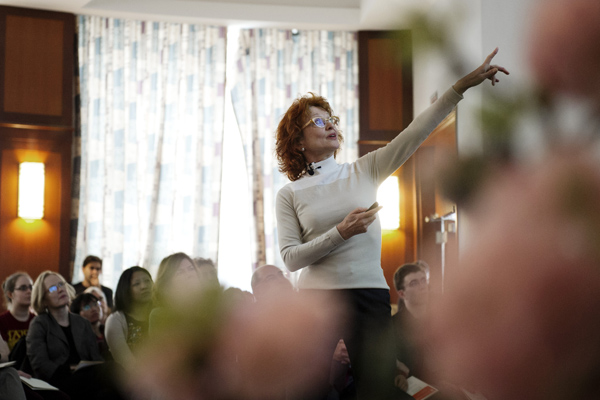The wonder of human movement

To watch a ballerina move is to observe, perhaps, the pinnacle of coordination, to experience precise and exquisite elegance. But now imagine a rhythmic gymnast, who must not only move with the articulated grace of a dancer but must simultaneously manipulate a ball, hoop, or ribbon with extreme control.
“She extends her movements toward the object. She is one with the object,” said Dagmar Sternad, professor of biology, electrical and computer engineering, and physics at Northeastern.
On Tuesday afternoon, Sternad received the 50th annual Robert D. Klein University Lecturer Award and delivered her university lecture, titled “The wonder of human movement: How the brain controls the body.” She displayed images of gymnasts and dancers to highlight their incredible level of physical control.
On the flip side, she said, are individuals who suffer from disorders and ailments such as Parkinson’s disease, cerebral palsy, or stroke. Damage to the neural system of the brain robs these patients of control over their limbs and movements. “We have no cure,” Sternad said. “We have ways to ameliorate the symptoms, but no cure.”
The Robert D. Klein University Lecturer Award, established in 1964 upon the recommendation of the Faculty Senate, honors a member of the faculty who has contributed with distinction to his or her own field of study. In 1979, it was renamed in tribute to the late Klein, a revered professor of mathematics and a leader in the Faculty Senate.
Stephen W. Director, provost and senior vice president for academic affairs, presented the award to Sternard. Director characterized her as “a brilliant educator, a remarkable speaker, a leader, and an impassioned researcher.”
Sternad, who directs the Action Lab at Northeastern, is an internationally known authority in the field of experimental and computational motor neuroscience. Her diverse academic career has spanned the disciplines of movement science, English linguistics and literature, experimental psychology, neuroscience, and kinesiology. Her studies of human motor control and learning have shed light on neurological defects in Parkinson patients, children with dystonia, and individuals who have suffered strokes.
In her lecture, Sternad elaborated on the complexity of the human brain, which consists of between 10 billion and 100 billion neurons, each making thousands of connections with all the others. “This is an unfathomable network with 100 trillion connections,” she explained. How does this infinitely complex structure turn information into physical movements? And how can we use that process to help patients who cannot control their movements?
In a first step to answering these questions, developing appropriate interventions for patients, and understanding how ballerinas and gymnasts achieve such remarkable control over their movements, Sternad’s team works backwards. Instead of starting with the neurons that cause the movement, they start with the behavior.
“We start by picking a task that is interesting,” Sternad said. This may be carrying a cup of coffee or bouncing a ball. They then work to understand the physics of the task in order to render it in a virtual environment, where they can experimentally probe a human’s performance. Based on what they learn, they can design interventions to help people modify their movements.
“It is unlikely that humans control their movements by learning the precise muscles that are controlling a given task,” Sternad explained. Instead, we gather extrinsic information about it, such as performance feedback in a game. “We then find solutions in the task that make our variability less detrimental.”
Her research has shown that though we may not understand the mathematical calculations that go into a task, we learn and respond to its physics the more we practice it. For instance, in the game table skittles, in which a player must skillfully launch a tethered ball in order to knock down a small pin, there are areas on the ball’s elliptical trajectory where releasing it will be more likely to result in success. Though we may not know this, as we perform the game over and over we begin to release the ball just inside that sweet spot, she said.
Her work has shown that people with Parkinson’s disease have control over their trajectory but not over the timing of their release of the ball. “We can [use] that insight to focus our interventions,” she explained.
Still, even the most highly trained and skilled athletes can crack under pressure. In order to simulate the sense of competition threat that may be present during, say, the Olympics or the World Series, Sternad has partnered with Northeastern University psychology professor Stephen Harkins to develop experiments in which participants must play the game either with or without additional information about their likelihood of success. “We tell them there are gender differences,” she said. Indeed, invoking threat causes that nuanced communication between brain and body to degrade. “So mind matters,” Sternad said.





